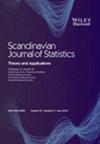克里金模型的 G 优化网格设计
IF 1
4区 数学
Q3 STATISTICS & PROBABILITY
引用次数: 0
摘要
这项工作的重点是为具有二维输入和可分离指数协方差结构的克里金模型从理论上找到 G 最佳设计。为了进行设计比较,提出了二维网格设计的均匀性概念。研究了设计与均方预测误差(SMSPE)函数上确界之间的数学关系,然后探讨了前瞻性设计和回顾性设计两种情况下的最优设计。在前瞻性设计的情况下,新设计是在实验进行之前开发的,而规则间隔的网格被证明是 G 最佳设计。回顾性设计是通过在已有设计中添加或删除点来构建的。我们开发了确定性算法来寻找最佳的回顾性设计(使 SMSPE 最小)。研究发现,在 G 最佳准则下,更均匀分布的设计会导致最佳的回顾性设计。在寻找最优前瞻性设计和最佳回顾性设计的所有情况下,都考虑了频繁主义和贝叶斯框架。我们用一个时空河流水质监测实验来说明所提出的寻找回溯设计的方法。本文章由计算机程序翻译,如有差异,请以英文原文为准。
G-optimal grid designs for kriging models
This work is focused on finding G -optimal designs theoretically for kriging models with two -dimensional inputs and separable exponential covariance structures. For design comparison, the notion of evenness of two-dimensional grid designs is developed. The mathematical relationship between the design and the supremum of the mean squared prediction error (SMSPE) function is studied and then optimal designs are explored for both prospective and retrospective design scenarios. In the case of prospective designs, the new design is developed before the experiment is conducted and the regularly spaced grid is shown to be the G -optimal design. Retrospective designs are constructed by adding or deleting points from an already existing design. Deterministic algorithms are developed to find the best possible retrospective designs (which minimizes the SMSPE). It is found that a more evenly spread design under the G -optimality criterion leads to the best possible retrospective design. For all the cases of finding the optimal prospective designs and the best possible retrospective designs, both frequentist and Bayesian frameworks have been considered. The proposed methodology for finding retrospective designs is illustrated with a spatio-temporal river water quality monitoring experiment.
求助全文
通过发布文献求助,成功后即可免费获取论文全文。
去求助
来源期刊

Scandinavian Journal of Statistics
数学-统计学与概率论
CiteScore
1.80
自引率
0.00%
发文量
61
审稿时长
6-12 weeks
期刊介绍:
The Scandinavian Journal of Statistics is internationally recognised as one of the leading statistical journals in the world. It was founded in 1974 by four Scandinavian statistical societies. Today more than eighty per cent of the manuscripts are submitted from outside Scandinavia.
It is an international journal devoted to reporting significant and innovative original contributions to statistical methodology, both theory and applications.
The journal specializes in statistical modelling showing particular appreciation of the underlying substantive research problems.
The emergence of specialized methods for analysing longitudinal and spatial data is just one example of an area of important methodological development in which the Scandinavian Journal of Statistics has a particular niche.
 求助内容:
求助内容: 应助结果提醒方式:
应助结果提醒方式:


